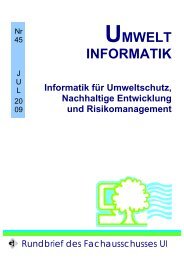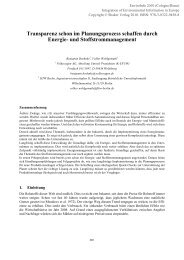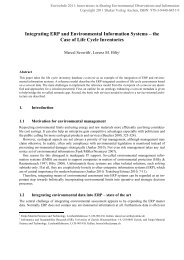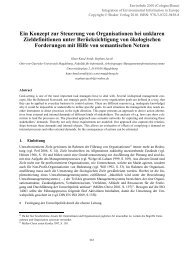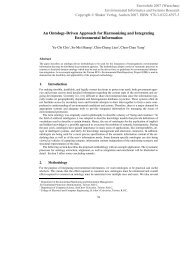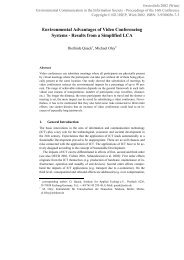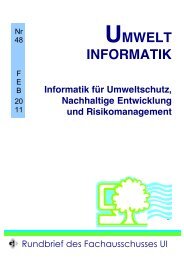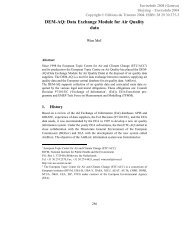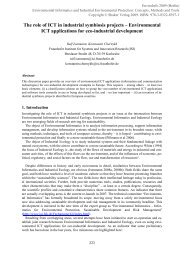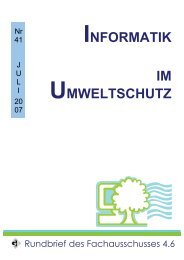Floating Car Data as Data Source for Modelling of Air ... - EnviroInfo
Floating Car Data as Data Source for Modelling of Air ... - EnviroInfo
Floating Car Data as Data Source for Modelling of Air ... - EnviroInfo
You also want an ePaper? Increase the reach of your titles
YUMPU automatically turns print PDFs into web optimized ePapers that Google loves.
662<br />
mits a more differentiated view on the current traffic situation. Furthermore the network<br />
<strong>of</strong> expensive fixed traffic count devices (loop detectors) can be reduced to a<br />
minimum which may be necessary <strong>for</strong> reference purposes.<br />
As the availability <strong>of</strong> FCD depends on the presence <strong>of</strong> specially equipped vehicles<br />
a fe<strong>as</strong>ible vehicle flow will first be reached in urban are<strong>as</strong> where<strong>as</strong> little in<strong>for</strong>mation<br />
will be available in rural are<strong>as</strong>. As most environmental problems related to transport<br />
occur in urban are<strong>as</strong> or along routes with high traffic flow (e.g. congestion, peaks <strong>of</strong><br />
air pollution, high noise emissions) the method delivers data precisely where it is<br />
most urgently needed.<br />
For the calculation <strong>of</strong> emissions from the transport sector an estimation <strong>of</strong> traffic<br />
flow on a specified road segment h<strong>as</strong> to be available. As FCD mainly deliver position<br />
and speed <strong>of</strong> vehicles the parameter traffic flow on a certain road segment h<strong>as</strong> to<br />
be estimated from further in<strong>for</strong>mation on the road segment (e.g. number <strong>of</strong> lanes,<br />
traffic light ph<strong>as</strong>es and development <strong>of</strong> <strong>as</strong>sociated waiting queue, historical and realtime<br />
data from detectors) and speed. As the vehicle fleet equipped <strong>for</strong> transmitting<br />
<strong>Floating</strong> <strong>Car</strong> <strong>Data</strong> is only a representative sample <strong>for</strong> the whole vehicle fleet the exact<br />
traffic flow and vehicle cl<strong>as</strong>sification will still require the use <strong>of</strong> appropriate loop<br />
detectors.<br />
3. Generating In<strong>for</strong>mation from <strong>Floating</strong> <strong>Car</strong> <strong>Data</strong> <strong>for</strong> Status and<br />
Impact <strong>of</strong> Transport Related Activities<br />
3.1 Atmospheric pollutants<br />
Current approaches to estimate emissions from road traffic all combine an emission<br />
factor with available in<strong>for</strong>mation on vehicle mileage [Ntziachristos and Samar<strong>as</strong>,<br />
2000]. This very simple approach is complicated by the necessity to separate different<br />
vehicle types and vehicle concepts (e.g. Diesel vs. g<strong>as</strong>oline driven cars, with or<br />
without catalytic converter). Emission factors are also available <strong>for</strong> different driving<br />
conditions, ranging from stop-and-go traffic to highway speed traffic. Now the vehicle<br />
fleet may be determined from car registration numbers, or from occ<strong>as</strong>ional <strong>as</strong><br />
well <strong>as</strong> from continuous traffic counts (loop detectors). Also, vehicle mileage <strong>as</strong> well<br />
<strong>as</strong> temporal distribution <strong>of</strong> emissions may be estimated from such traffic counts.<br />
However, especially in cities the number <strong>of</strong> traffic count sites is relatively small in<br />
respect to total mileage and requires the use <strong>of</strong> outputs from sophisticated traffic<br />
models, if at all available. Additionally, speed distribution is very difficult to <strong>as</strong>sess.<br />
Vehicle speed is not only required to apply the correct emission factor, but even the<br />
ratio between different pollutants. Emissions <strong>of</strong> Nitrogen oxides (NO x ) tend to be<br />
higher at higher motor temperatures and speeds, compounds emitted due to incomplete<br />
combustion (carbon monoxide (CO) and volatile organic compounds (VOC))<br />
tend to be extremely high during stop-and-go traffic.<br />
29.08.02, 9202 EI P 074 I2 NowotnyB.doc<br />
Copyright © IGU/ISEP, Wien 2002. ISBN: 3-9500036-7-3






